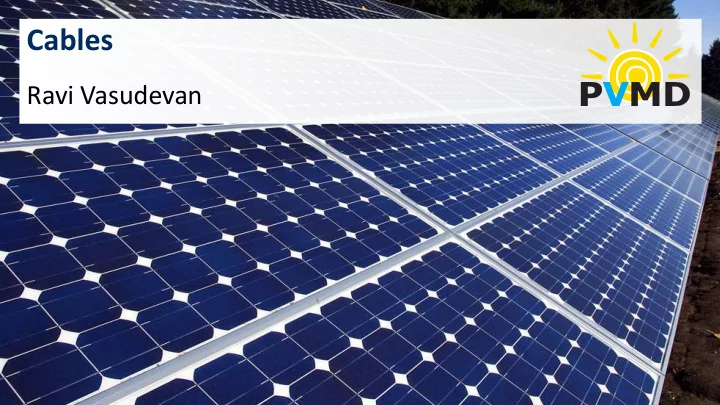

Cables Ravi Vasudevan PVMD Delft University of Technology
Learning objective 1. Maximum Power Point Tracking 1. Introduction to MPPT 2. Indirect Methods 3. Perturb and Observe 4. Incremental Conductance 5. Cost and Overview 2. Cables 3. Batteries 1. Introduction to Batteries 2. Characteristics of Batteries 3. Charge Controller
Components PV Panels Balance of System (BoS) Outputs Modules Charge Storage Cables Controller Grid DC/DC Mounting Inverter Converter Frames Bypass Diodes
Components PV Panels Balance of System (BoS) Outputs Cables
Components There are different types of cables • § DC cables Red for the positive cable • Black for the negative cable •
Components There are different types of cables • § DC cables Red for the positive cable • Black for the negative cable • § AC cables Usually thin • Phase (live) wire • Neutral wire • Earth (ground) wire • insulation
Components There are different types of cables • § DC cables Red for the positive cable • Black for the negative cable • EU USA India Kenya § AC cables Canada Pakistan Usually thin • Phase Brown Black Blue Red Phase (live) wire • Red Neutral wire • Yellow Earth (ground) wire • Neutral Blue Silver Black Black insulation Earth Green Green Green Green Yellow Yellow Yellow
Cable Thickness Calculation • For the DC cables • From the solar panels to the charge controller • From the charge controller to the batteries From the batteries to the inverter • 4, 6, 10, … , 16 mm 2 • • For the DC cables interconnecting the batteries • 25, …, 35 mm 2 • For the AC cables form the inverter to the loads 1.5 – 2.5 mm 2 •
Power Loss As current flows through a wire, some energy is always lost into heat • How much? It depends on § Current (more amperes, more energy lost) • Length (longer cable, more energy lost) • Thickness (thinner cable, more energy lost) • Material (Cu conducts better than Al) •
Power Loss The amount of power lost in a certain cable can be calculated with the • following formula: 2 V = = 2 P I R cable cable cable R cable
Power Loss The amount of power lost in a certain cable can be calculated with the • following formula: 2 V = = 2 P I R cable cable cable R cable Where: • l 1 l = r = R cable s A A
Power Loss The amount of power lost in a certain cable can be calculated with the • following formula: 2 V = = 2 P I R cable cable cable R cable Where: • l 1 l = r = R cable s A A Resistivity [Ω mm 2 /m]
Power Loss The amount of power lost in a certain cable can be calculated with the • following formula: 2 V = = 2 P I R cable cable cable R cable Where: • l 1 l = r = R cable s A A Resistivity [Ω mm 2 /m] Conductivity [S m/mm 2 ]
Power Loss The amount of power lost in a certain cable can be calculated with the • following formula: 2 V = = 2 P I R cable cable cable R cable Where: • l 1 l = r = R cable σ Cu = 59.6 S m/mm 2 s A A σ Al = 35.5 S m/mm 2 Resistivity [Ω mm 2 /m] Conductivity [S m/mm 2 ]
Power Loss The amount of power lost in a certain cable can be calculated with the • following formula: 2 V = = 2 P I R cable cable cable R cable In general, using shorter and thicker Where: • cables reduces the power losses l 1 l = r = R cable σ Cu = 59.6 S m/mm 2 s A A σ Al = 35.5 S m/mm 2 Resistivity [Ω mm 2 /m] Conductivity [S m/mm 2 ]
Cable Efficiency
Voltage drop in cables R Cable + + PV Loads V PV V Load - - R Cable
Voltage drop in cables R Cable + + PV Loads V PV V Load - - R Cable
Recommend
More recommend